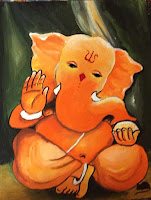In the earlier 2 parts of Blog - How to Sell Arts Successfully? Artist Sonjaye Maurya shared that the emerging artist should have not just a couple of paintings and initiate selling but should paint more paintings before planning to sell them. Another important fact to be considered is to Not paint to sell but paint with all the emotions and heart out. He also suggested the artist should not only tap various offline galleries and exhibitions but also online sites. Below are the 2 links to know have detailed info of earlier parts of Blog:
1) How to Sell Arts Successfully? Part I & 2) How to Sell Arts Successfully? Part II
Now the concluding part:
Once you have a portfolio with you, plan to promote it. Set out to get your Art Seen. It helps to set goals of where you want to be in a few years’ time. It is said that a piece of art is your own voice. Do take your own liberty to express yourself. But be little considerate too, in order to make a sale of your art. This means your work should have a mass appeal - a style, a subject liked by many. Your work must have a subject, a theme, to which, people can relate themselves easily to. If you are not selling, and funds are what is needed to continually produce and promote art, some changes may have to be made. Look for general trends in the art world, and find out what people are buying and writing about.
Write regularly, about the artworks you are working on currently. Create an Art blog and start blogging about random thoughts, processes, and works in progress. Whether it is a certain concept, subject, or theme, an art buyer will appreciate the piece more if they can know what it means, and why you created it. Have some of this conveyed through your artwork title, but try to enlighten an art buyer with a summary of what inspired you, so that they can easily explain it to others who will ask questions. Have a website to sell your artworks. It’s the most promising tool for selling in today’s digital age. If you cannot make a website on your own, spend some amount to hire help to create it for you.
Pricing your work entirely depends on what stage you are in your art career. Add value to your work. Good presentation, framing of reasonably good size enhances your artwork. Smaller is better.
A lot of artist (including myself) want to make big painting, sometimes of a gigantic proportion. It’s a fantasy of every artist. But you have to think of practicality too. Maybe a big size painting allows you to give ease with big brush stroke to flow or your style of giving finer details comes through better. But small size paintings are affordable. They can be easily framed and hanged anywhere. Easy to transport or ship. High end art is only for an exclusive few.
Look at the prices of other artists in your stage of artistic development. Visit art galleries or search for prices online. Explain your prices in practical language to anyone who asks, and never base it on emotions. For example, tell them your painting took certain amount of time to create along with cost of materials involved, instead of saying you price it higher because it has personal meaning. Unless they know you, they will not understand the significance of your personal attachment to the painting. If you can convey that the artwork has a certain tangible value related to the time spent, artistic skill success, cost of materials, etc., the art buyer is more likely to buy the artwork.
When a person views an artwork, they often want to buy it because they see something in it that relates to them. They have an emotional reaction to the piece, which stirs them to want to buy it. There are a lot of things that contribute to the value of an artwork. How it is presented, where it is showcased, all helps to increase the perceived value. An artwork displayed in a gallery would certainly appear more valuable than one in a coffee shop. That is not to say you should not display in a coffee shop, especially if you are an emerging artist. It is effective for name recognition.
 ⮜⎯⎯⎯⎯ Tanjore Paintings
⮜⎯⎯⎯⎯ Tanjore Paintings
Happy Selling....!





